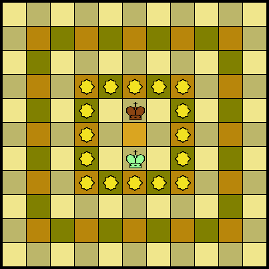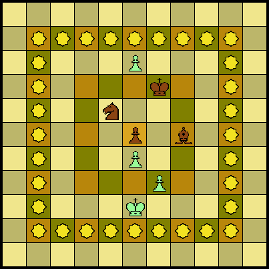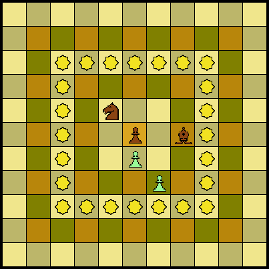BigBangChess
Following on from my last physics inspired variant that took ideas from the Lilliputian realm of reality, this variant is inspired by the Brobdingnagion description of reality, namely the Big Bang theory with the its expanding universe and the creation of matter. This variant thus has a playing area that starts small with only the Kings in play and then expands as the pieces are dropped and later contracts as pieces are captured.As is usual for me, my concern is with the playing surface rather than the properties of the pieces.  Thus this variant is played by two opponents using the standard FIDE set of pieces, with some minor adjustments to their movement.  In the following description the two players are referred to as Light and Dark.
Setup
This is shown in the next image below.The board consists of 121 squares (11x11) but play starts with just the two Kings separated by a single square in the central 3x3 part of the board. Â The remaining pieces start the game off-board. Â The Dark player has the red/brown pieces while the Light player has the pale green/blue pieces.

Pieces
The pieces are the standard FIDE set with the following adjustments:- There is no castling.
- There is no double-step first move for Pawns and thus no en-passant capture,
- There is no Pawn promotion.
- Pawns may move one-step diagonally backwards into an empty square.

Rules
1. Winning      To win, capture the enemy king. Â
|
2. Board Expansion
and
Contraction The dimensions of the playing area will vary throughout the game: expanding as pieces are dropped and contracting as pieces are captured. The image on the right shows the position after the first pawn has been dropped. Â The playable board size has expanded to 5x5.
|
 |
|||||||||||||
|
3. Capture by
Board Contraction The board size will always be the smallest possible for the number of pieces in play.  Capturing a piece may thus result in a contraction of the playing area.  When the board contracts any pieces that were on the edge of the old playing area will be captured. The two images (before and after contraction) on the right illustrate such a contraction caused by the dark King capturing the light Pawn.  Both Kings are captured by the contraction, but as the player with the dark pieces was the last to move that player is the winner. |
 |
 |
||||||||||||
| 4. Drops Off-board pieces are brought into play by dropping them into any empty square that shares an edge with the square occupied by the friendly King. Â There is thus a maximum of 4 squares that may be used as the drop zone. Â Those for the Dark player are marked with a black dot in the right-hand image. Drops must be made in order according to the following table where Pawns are on the lowest level while the Queen is at the highest. Â Thus four Pawns must be dropped before dropping a Knight or Bishop, and so on...
|
 |
|||||||||||||
Notes
- This variant is very conservative in its choice of pieces.  It might be interesting to extend the concepts of a mutating board and drops to other variants such as Christian Freeling's Grand Chess, Courier Chess or Great Shatranj.
- I suspect that the piece values are about the same as for FIDE chess, a speculation that is supported by my ZoG implementation.
 This 'user submitted' page is a collaboration between the posting user and the Chess Variant Pages. Registered contributors to the Chess Variant Pages have the ability to post their own works, subject to review and editing by the Chess Variant Pages Editorial Staff.
This 'user submitted' page is a collaboration between the posting user and the Chess Variant Pages. Registered contributors to the Chess Variant Pages have the ability to post their own works, subject to review and editing by the Chess Variant Pages Editorial Staff.
By Graeme C Neatham.
Web page created: 2011-01-21. Web page last updated: 2011-01-21